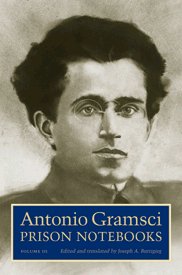Prison Notebooks
Date: 1926
Region: Europe
Subject: Political/Economic/Social Opinion
Medium: Literature
Artist: Antonio Gramsci
Confronting Bodies: Italian Fascist Party, Italian Communist Party
Dates of Action: 1926
Location: Italy
Description of Artwork: Antonio Gramsci's Prison Notebooks were written during his imprisonment and compromise 33 notebooks with chapter-length essays, largely unedited. This left the notebooks hard to discern and open to interpretation. The most common interpretation outlines the "Italian road to socialism" which was a strategy for attaining Marxist goals in Italy. Gramsci argued for the attainment of these goals through cultural means, such as education and persuasion. This was in contrast to Bolshevism which held that one had to first conquer the social and cultural institutions and then this would yield a change. The theory outlined in Prison Notebooks is called Gramsci's theory of hegemony.
The Incident: After World War I there was a period of unrest in Italy which saw a number of worker revolts and movements. The workers faced defeat after a worker occupation from 1919-1920 and Gramsci saw the opportunity for a reorganization of Italian socialists. In 1921 the Italian Communist Party was formed. In 1922 the fascists gained control of the government and arrested communist leaders. Gramsci escaped arrest because he was in the Soviet Union representing his party at the Communist International. In 1924 Gramsci was elected to the parliament on the Communist Party ticket and was selected as the new leader of the party.
In 1926 special laws were passed by the fascists in defense of the state and all opposition parties were outlawed and their leaders arrested. Gramsci was sentenced to twenty years in prison and ended up dying in jail in 1937 as a result of poor health that was exacerbated by bad prison conditions.
Prison Notebooks was translated by Gramsci's successor as head of the Italian Communist Party, Palmiro Togliatti, and the strategy outlined in the books was very popular and successful until the late 1970s. With the collapse of the Soviet Union Gramsci's theories became almost obsolete. Togliatti's interpretation of Prison Notebooks was a political reconstruction that amounted to a form of censorship. It has been argued that in Prison Notebooks Gramsci was not only questioning the approaches of the Communists, but also the results.
Results of Incident: A critical edition of Prison Notebooks did not appear until 1975 and a new national critical edition is being planned. Gramsci's works were never popular in the Soviet Union because of the distinction Gramsci made in his theories between the east and the west. In the west his writings are still viewed with suspicion for being too close to communism.
Source: Censorship: A World Encyclopedia
